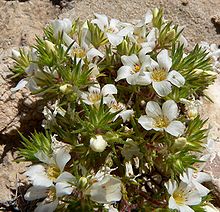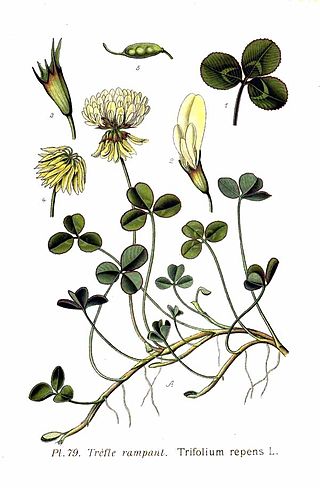
Clover, also called trefoil, are plants of the genus Trifolium, consisting of about 300 species of flowering plants in the legume family Fabaceae originating in Europe. The genus has a cosmopolitan distribution with highest diversity in the temperate Northern Hemisphere, but many species also occur in South America and Africa, including at high altitudes on mountains in the tropics. They are small annual, biennial, or short-lived perennial herbaceous plants, typically growing up to 30 centimetres (12 in) tall. The leaves are trifoliate, with stipules adnate to the leaf-stalk, and heads or dense spikes of small red, purple, white, or yellow flowers; the small, few-seeded pods are enclosed in the calyx. Other closely related genera often called clovers include Melilotus and Medicago.

Lupinus, commonly known as lupin, lupine, or regionally bluebonnet, is a genus of plants in the legume family Fabaceae. The genus includes over 199 species, with centers of diversity in North and South America. Smaller centers occur in North Africa and the Mediterranean. They are widely cultivated, both as a food source and as ornamental plants, but are invasive to some areas.
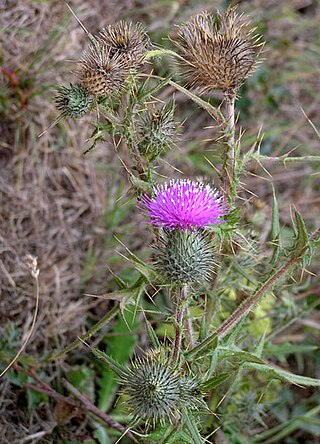
Cirsium is a genus of perennial and biennial flowering plants in the Asteraceae, one of several genera known commonly as thistles. They are more precisely known as plume thistles. These differ from other thistle genera in having feathered hairs to their achenes. The other genera have a pappus of simple unbranched hairs.

Ceanothus is a genus of about 50–60 species of nitrogen-fixing shrubs and small trees in the buckthorn family (Rhamnaceae). Common names for members of this genus are buckbrush, California lilac, soap bush, or just ceanothus. "Ceanothus" comes from Ancient Greek: κεάνωθος (keanōthos), which was applied by Theophrastus to an Old World plant believed to be Cirsium arvense.

The Polemoniaceae are a family of flowering plants consisting of about 27 genera with 270–400 species of annuals and perennials native to the Northern Hemisphere and South America, with the center of diversity in western North America.

Lomatium is a genus in the family Apiaceae. It consists of about 100 species. Its common names include biscuitroot, Indian parsley, and desert parsley. It is in the family Apiaceae and therefore related to many familiar edible species such as carrots and celery. Native to western Northern America and northern Mexico, some Lomatium species are extensively used by Native Americans in the inland Pacific Northwest as a staple food.
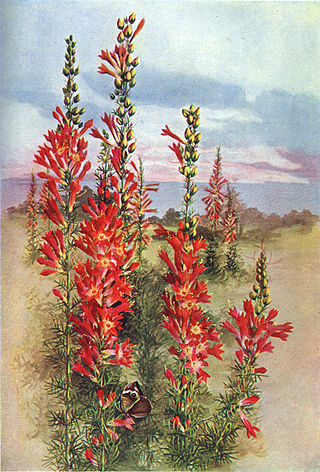
Ipomopsis is a genus of flowering plants in the phlox family, Polemoniaceae. The annual and perennial herbs it contains are native to the Americas, particularly North America.

Gilia is a genus of flowering plants in the Polemoniaceae family and is related to phlox. It includes 39 species native to the Americas, ranging from British Columbia to Texas and northern Mexico, and to Ohio, in North America, and from Ecuador and Peru to southern Chile and Argentina in South America. These Western native plants are best sown in sunny, well-draining soil in the temperate and tropical regions of the Americas, where they occur mainly in desert or semi-desert habitats
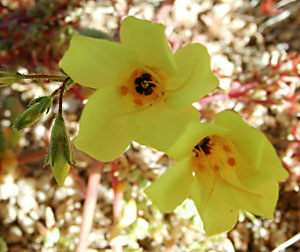
Leptosiphon is a genus of flowering plants in the Polemoniaceae family. Many included species were formerly classified as members of the genus Linanthus. Some species of this genus are grown as ornamental plants.

Streptanthus is a genus of plants within the family Brassicaceae. There are 58 known species within the genus Streptanthus, distributed through the western and south-central United States and northern Mexico. The common names for this genus are twistflower and jewelflower. Twenty-four of the species and eleven lesser taxa occur in California, thirty-two of which are California endemics; seventeen of these California taxa are classified as rare plants.
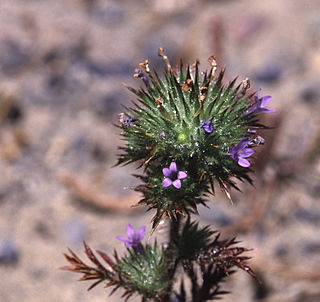
Navarretia is a genus of flowering plants related to the phloxes and the gilias. This is one genus of plants, among others, which are sometimes called pincushion plants. It includes 45 species native to the Americas. In North America they range from western Canada through the western and west-central United States to northwestern Mexico, and to Ohio and Pennsylvania. In South America they range through Argentina and Chile.

Aliciella is a genus of plants in the phlox family. It includes 23 species native to the western United States and northwestern Mexico. These plants have been treated as members of genus Gilia until recently, when it was proposed they be moved back to Aliciella. This genus was created in 1905 to include certain gilias that seemed distinct from most of the others, but it was abandoned soon after. Recent genetic analyses suggest it should be revived.

Acmispon is a genus of flowering plant in the family Fabaceae (legumes), native to North America and the west coast of Chile in South America. It includes several species of American bird's-foot trefoils and deervetches formerly contained in the globally distributed genus Lotus. The former genus Syrmatium is included in Acmispon. The Jepson eFlora accepts only Acmispon.

Diplacus is a plant genus in the family Phrymaceae, which was traditionally placed in family Scrophulariaceae. In the 2012 restructuring of Mimulus by Barker, et al., based largely upon DNA evidence, seven species were left in Mimulus, 111 placed into Erythranthe, 46 placed into Diplacus, two placed in Uvedalia, and one each placed in Elacholoma, Mimetanthe, and Thyridia. Diplacus used to be a separate genus from Mimulus, but it was merged into Mimulus no later than 1905, until the 2012 restructuring. Dry and rocky areas are preferred.
